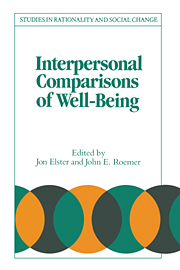Book contents
- Frontmatter
- Contents
- List of contributors
- Acknowledgments
- Introduction
- 1 The moral basis of interpersonal comparisons
- 2 Against the taste model
- 3 Utilitarian metaphysics?
- 4 Local justice and interpersonal comparisons
- 5 Notes on the psychology of utility
- 6 Adult-equivalence scales, interpersonal comparisons of well-being, and applied welfare economics
- 7 Interpersonal comparisons of utility: Why and how they are and should be made
- 8 A reconsideration of the Harsanyi–Sen debate on utilitarianism
- 9 Deducing interpersonal comparisons from local expertise Ignacio
- 10 Subjective interpersonal comparison
- 11 Utilitarian fundamentalism and limited information
- Index
6 - Adult-equivalence scales, interpersonal comparisons of well-being, and applied welfare economics
Published online by Cambridge University Press: 05 June 2012
- Frontmatter
- Contents
- List of contributors
- Acknowledgments
- Introduction
- 1 The moral basis of interpersonal comparisons
- 2 Against the taste model
- 3 Utilitarian metaphysics?
- 4 Local justice and interpersonal comparisons
- 5 Notes on the psychology of utility
- 6 Adult-equivalence scales, interpersonal comparisons of well-being, and applied welfare economics
- 7 Interpersonal comparisons of utility: Why and how they are and should be made
- 8 A reconsideration of the Harsanyi–Sen debate on utilitarianism
- 9 Deducing interpersonal comparisons from local expertise Ignacio
- 10 Subjective interpersonal comparison
- 11 Utilitarian fundamentalism and limited information
- Index
Summary
Introduction
Social evaluations in economic environments are often performed with consumer's-surplus tests. For example, one such test employs each household's “willingness to pay” net of costs (Hicksian consumer's surplus) for an economic change, and declares the change worthwhile if and only if the simple sum of these numbers is positive.
If household demand behavior is consistent with a standard indifference map, then a positive willingness to pay indicates an improvement for the household in question, according to household preferences. No account is taken of household members as individuals, however, and, at the aggregate level, no attention is paid to income distribution. Further, these tests do not order social alternatives consistently unless a strong (and implausible) restriction on household preferences is satisfied (Blackorby and Donaldson [1985, 1990]).
In this chapter we investigate adult-equivalence scales and their potential for applied welfare economics. These scales permit comparisons of levels of well-being between people who are members of different households, and the social-evaluation procedure described uses these comparisons to perform consistent social evaluations that:
Deal with the general equilibrium problem (price change).
Explicitly model the fact that economic behavior rests on household decisions while individual household members experience well-being or utility.
Take account of economies of scale in household consumption.
Base social evaluations on individual (rather than “household”) well-being.
Take account of inequality of well-being and therefore of incomes.
- Type
- Chapter
- Information
- Interpersonal Comparisons of Well-Being , pp. 164 - 199Publisher: Cambridge University PressPrint publication year: 1991
- 24
- Cited by



